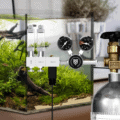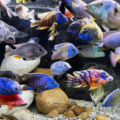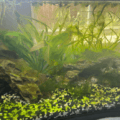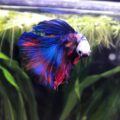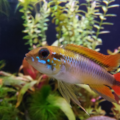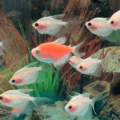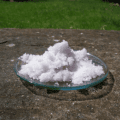The convict cichlid generally referred to as Amatitlania nigrofasciata, is a stunning freshwater fish species that has caught the interest of aquarists worldwide. Its captivating behavior, visually appealing appearance, and relatively straightforward care requirements make it a popular choice among enthusiasts. This article will teach you everything that you will need to know about this captivating fish

Characteristics
The convict cichlid is a small to medium-sized fish with an elongated oval-shaped body. The main distinctive feature is the contrasting black and white vertical stripes that adorn its body, resembling the appearance of a convict’s uniform, hence the name. These stripes are more prominent in males, especially during breeding.
| Scientific name | Amatitlania nigrofasciata |
| Common name | Convict Cichlid |
| Origin | Central America (Honduras, Nicaragua, Guatemala, Costa Rica) |
| Size | 4-6 inches |
| Lifespan | 5-8 years |
| Tank size | Minimum 20 gallons for a pair |
Origin
Native to Central America, particularly Honduras, Nicaragua, Guatemala, and Costa Rica, the convict cichlid inhabits various freshwater habitats, including rivers, streams, and ponds. It prefers slow-moving waters with plenty of hiding spots among rocks, driftwood, and vegetation.

Size
Convict cichlids size can grow to around 4-6 inches (10–15 centimeters) in length under normal conditions; however, females are slightly smaller than males. In confinement, they might attain a larger size, contingent on factors like dietary intake, water quality, and tank parameters.
Life Span
If properly taken care of, convict cichlids could survive for nearly 5–8 years; nonetheless, many cichlids have been seen to live for longer in perfect circumstances.
Colors and markings
Classic black and white stripes are the characteristic coloration of convict cichlids; however, there are albino and gold convict cichlids too. These variations are devoid of black pigment and show lighter coloration, with albinos being entirely white and gold convict exhibiting a yellow shade.

Right Aquarium Size and Life Span
A tank size of at least 30 gallons is suggested with surplus space for additional fish or breeding pairs for a single pair of convict cichlids. Hiding spots and playing areas should be provided, which could mitigate aggression and depression in the tank.
Tankmates
While considering convict cichlids tank mates, it is essential to evaluate their aggressiveness, particularly during breeding season. Don’t keep convict cichlids with small fish species that might be targets of aggression.
Friendly tankmates consist of vigorous cichlid species with common temperaments, for instance, Jack Dempsey, firemouth cichlids, and Salvini cichlids. Furthermore, larger peace-loving fish species such as silver dollars, giant danios, and plecos can co-exist with convicts in a community tank setup.
Care:
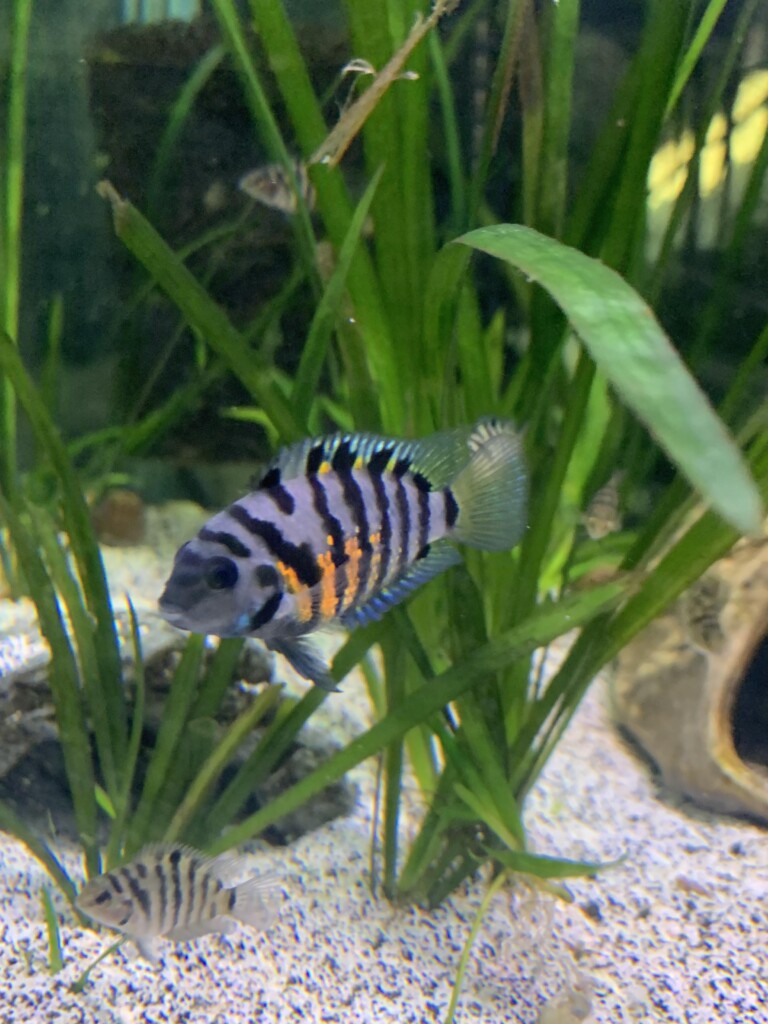
Proper and appropriate care should be taken to maintain the wellness and well-being of convicts. Some strategies are here to maintain optimal conditions for the convict cichlid care.
Water parameters:
Convict cichlids grow in slightly basic water with a pH range of 6.5 to 8.0 and a required temperature range of 75–80°F (24–27°C). Regularly testing ammonia, nitrate, and nitrite levels is crucial to avoiding poor water quality.
Tank Setup:
Provide abundant hiding spots and caves with the help of rocks, driftwood, and artificial embellishments to copy the natural habitat of convict cichlids. A fine-granulated substrate like sand or smooth gravel is perfect for assisting burrowing behavior.
Filtration:
A good filtration system is recommended to maintain good water quality. Convict cichlids produce a considerable amount of waste because they are messy eaters, so a proper filtration system is necessary for a favorable environment.
Regular maintenance:
Change water weekly by 25–30% to eliminate pile-up waste and replace essential minerals and trace elements. Remove all the debris and detritus by vacuuming the substrate and cut any grown vegetation to avoid algae issues.
Diet and Feeding
For better health and vibrant coloration of convict cichlids, the provision of nutritious diets is necessary.
Convict cichlids are omnivorous and display varied feeding behavior, eating various small invertebrates, algae, and plant matter. Replication in confinement needs intense attention and devotion.
In their natural habitat, they feed on a variety of diets specially formulated to fulfill the nutritional requirements of cichlids. Provide supplementary frozen or live foods to mimic their natural feeds, like bloodworms, brine shrimp, and bloodworms.
Include fresh vegetables to meet fiber needs. Algae wafers or spirulina-based foods can also be incorporated into diets.
Gender Differences
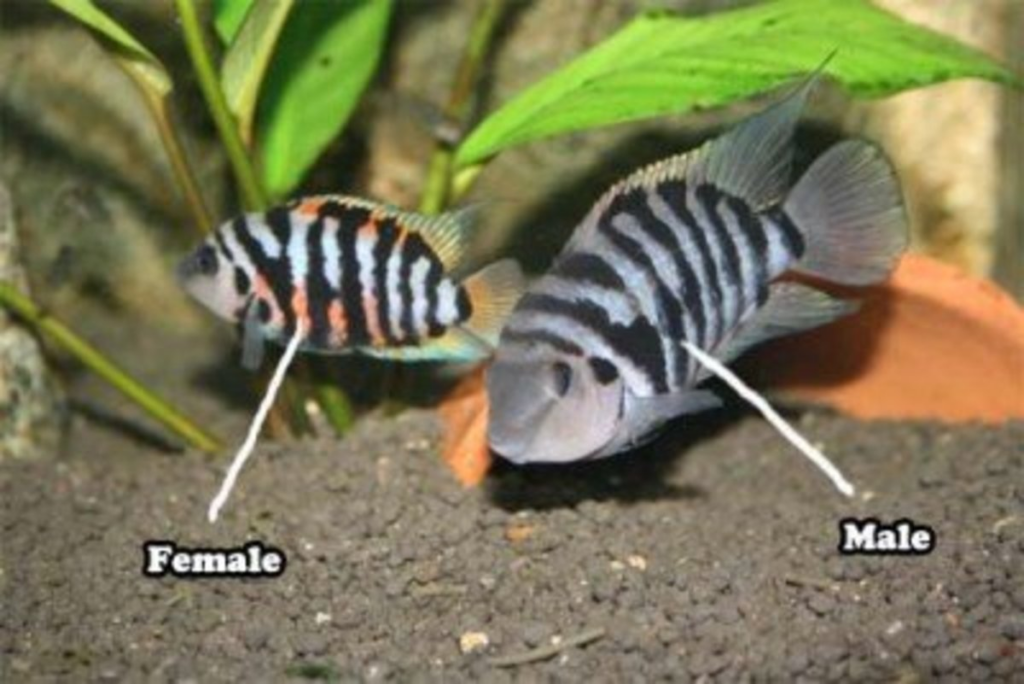
Distinguishing between convict cichlid male or female can be difficult, particularly when they are young. Notwithstanding, many physical traits can help differentiate gender.
Size:
Males normally grow larger and have longer dorsal and anal fins relative to females.
Coloration:
During the breeding season, males display more intense black colors to appeal to females.
Egg Spot:
Females typically have a tiny dark spot on the dorsal fin known as the “egg spot,” which is not present in males.
Breeding:
Breeding is an easy practice for convict cichlids and occurs spontaneously in good-quality aquariums.
Here are some successful convict cichlids breeding hacks.
Pair formation: Convict cichlids form monogamous pairings and display parental care for their fry by both parents. Introduce juvenile cichlids into a roomy aquarium and allow them to pair up naturally.
Breeding Site: Provide smooth and flat surfaces such as rocks, overturned flowerpots, or slate tile so that they can spawn freely. Convict cichlids eggs are lay on surfaces.
Spawning Behavior: Males show courtship behaviors for example digging pits, Flaring fins, and vibrating movements to appeal to females. Females in a pair lay eggs and males fertilize them. Both parents protect and provide security to eggs and fry.
Fry care: Post-hatching fry are shifted to crevices, where they are protected by parents. Feed small, nutrient-rich diets like newly hatched brine shrimp or crushed flakes until they can accept large-size feeds.
Conclusion
The convict cichlid is a captivating fish species that offers aquarists an exciting glimpse into the world of cichlid keeping.
By understanding their unique characteristics, care requirements, and breeding behavior, enthusiasts can create thriving aquariums that showcase the beauty and complexity of these remarkable fish.
With proper care and attention, convict cichlids can provide years of enjoyment and fascination for hobbyists of all levels.

